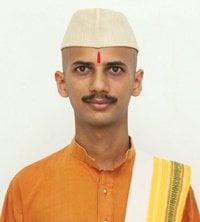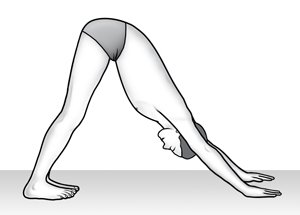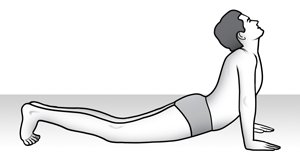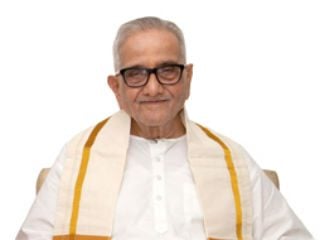
To reduce obesity perform exercises every day, massage with medicines, eat appropriate food and consume necessary medicines. If attempts are made at all these levels unnecessary fat stored in the body is decreased. Details on this are given further.
1. Exercise
1A. Rolling on the mattress or ground
In the morning when still in bed perform the following exercises on the mattress. Lying on the back hold both arms close to the ears and hands straight upwards and intertwine fingers. Roll over after turning to one side till one edge of the mattress and then to the other edge for a minute or two. If the mattress is small then do this exercise on the ground. If not possible to do immediately on waking up. Combine with other exercises later.
In the morning after passing stool perform as many exercises as possible with half the body energy. When breathing occurs through the mouth when exercising it implies that half the energy has been utilised so if more exercises have to be done then stop for some time and restart when breathing resumes through the nose smoothly. Start exercise after 5 minutes and increase stepwise. Once acclimatised to exercising perform exercise for 20 minutes daily.
1B. Contracting and relaxing abdominal muscles
Perform this activity 15 to 20 times either in standing or sitting posture.
1C. Suryanamaskar
Perform Suryanamaskar after a prayer unto the Sun Deity. Every day increase the number of namaskars. Regularly do 12 Suryanamskars. Details on Suryanamaskar are given In Sanatan’s Holy texts ‘Ideal day-to-day routine actions (Part 2) – Bath and actions to be performed after bath and the science underlying them’.
1D. Cobra pushup (bhujang dand)
This exercise helps in reducing a paunch, loss of appetite, incomplete evacuation of stool etc.
1D 1. Method of performing cobra pushup
- Sit with knees touching the ground and soles touching each other.
- Touch the part of the wrist at the edge of the palm of one hand (distance from elbow to tip of middle finger) and 1 span (distance between maximally stretched tip of thumb and little finger) away from the touched knee.
- Distance between palms should be 1 arm.
- Original posture : Touch soles to the ground completely. Raise the hip as much as possible and instead of bending the hand and legs at the elbow and knee respectively keep them straight and keep the head and back in line with the hand. In this state the body will appear like a mountain. (see figure 1)

- Bend the hands at the elbow. Bend the head and chest down and then the whole body. Move the head backwards as far as possible looking skywards and chest forwards. The body here appears like the hood of a cobra because of which this posture is called bhujang pushup (see figure 2).

- Raising the hip again return to the original state. This completes 1 pushup. Do 5-10 such pushups. Increase the number as per your capacity.
2. Oil massage
Every day before bath give yourself a massage. A list of substances which can be used for the massage are given further. Use any one medicine which is easily available and convenient o use. Massage thins down the fat decreasing it. Massage that part of the body where there is maximum fat for a longer time at least 5 minutes every day without fail, at least for 100 days. After massage as far as possible do not use soap. To prevent the towel and clothes from becoming oily use the following powders.
2A. Powders which can be used for massaging
Some of the medicines given further are in dry form. Before rubbing them onto the skin rub the body with sesame or coconut oil. But for massaging with medicines in the form of a juice or oil this is not necessary. However dry powders can be used to absorb the excess oil applied to the body.
1. Powder of skin of lime, orange or sweet lime
Break the skin into small pieces and dry them in the sun. Then make a fine powder in the mixer. Use 1 or 2 teaspoons of the powder at a time.
2. Powder of used and dried tea leaves
Take the remnants after straining tea. This contains sugar. So add water and stir it and strain again. This removes the sugar from it. If sugar is not put when boiling water for the tea then the strained material does not contain sugar. Dry this in the sun and powder it fine and use 1-2 teaspoons of it at a time.
3. A mixture of 4 teaspoons gram dal flour, 1/2 teaspoon turmeric powder and ¼ teaspoon camphor powder.
4. A mixture of 4 teaspoons of tur dal flour or horse gram flour and 1 teaspoon of lime juice
5. Half a bowl of fresh juice extracted from radish, maka, takla (green leafy vegetable) leaves, pomegranate leaves or orange flowers
6. Oil made from thickened kardai(safflowers) juice
Add half a bowl of juice extracted from grating kardai leaves to half a bowl of kardai oil till all the juice is absorbed and only the oil remains. When the oil cools filter and store in a bottle. Massage the entire body with this oil and bathe immediately. If this induces itching then stop using it. Also do not allow it to enter the eyes as it may induce itching, burning, pain, watering etc in the eyes. If there are no side effects of the oil prepare sufficient oil using the above method and use.
7. Takla oil
In a litre of sesame oil add an equal amount of juice of takla vegetable prepared with sufficient water and cook till only the oil remains. Then filter and store in a bottle.
3. Medicines
Every morning on an empty stomach take any one of the following medicines. Instead of honey an individual with diabetes should use warm water. If after using a medicine daily for a month there is no effect then try another medicine from the list for a month.
1. Consume 1 teaspoon of a powder prepared from fenugreek, ajwain(carom seeds) and fennel seeds in equal quantities in a cup of warm water.
2. Take 4 tablets of navak guggul or kanchanar guggul in half a cup of gomutra(cow’s urine) or warm water.
4. Diet
Eating only vegetables and stopping consumption of rice, bhakri(roti made from bajra or sorghum) etc is wrong. The diet should be a blend of all six flavours – sweet, sour, salty, pungent, bitter and acrid, out of which sweet, sour and salty should be the least but should not be stopped totally.
4A. Dietary indications (what to eat)
Jav (satu), green gram (moong), horse gram, buttermilk, takla vegetable, drumstick leaf vegetable, snake gourd, ridge gourd and capsicum help in reducing unwarranted fat. Hence they should be included in food to a great extent.
Obese individuals have more hunger. They should consume foods which satiate hunger yet do not increase fat. Based on liking choose 1-2 from this list. Eating the same thing everday is boring so change to another from that list.
1. Ripe tomatoes
2. Ridge gourd vegetable
3. Well roasted whitish groundnuts (the reddish ones have more fat content in comparison with the white ones)
4. Apples
5. Boiled green gram or its preparation with coconut (usal)**
6. Usal and soup (sar) of horse gram
7. Soup made from horse gram and snake gourd
Pressure cook 1 part horse gram and 10 parts of snake gourd and make a paste in the mixer. Add a teaspoon of cumin seeds, ¼ teaspoon of cinnamon, ½ teaspoon of ajwain and rock salt to taste.
8. Vegetable from tender leaves of takla and vari rice or bhajni bhakri
9. Bajri bhakri, onion and garlic
** Usal – preparation of a pulse with coconut and mild tempering with spices
4B. Dietary contraindications (what not to eat)
Eating till the stomach is full, eating continuously, eating oily foods, eating non-vegetarian, drinking excess water, drinking chilled water from the refrigerator, drinking water after a meal, taking an afternoon nap, sitting in an armchair
– Vaidya Meghraj Madhav Paradkar, Maharshi Vishwavidyalay, Goa (20.5.2016)

 Chikungunya: Symptoms and Treatment !
Chikungunya: Symptoms and Treatment ! Primary treatment in Ayurved
Primary treatment in Ayurved Simple remedies against fungal skin infections
Simple remedies against fungal skin infections Home remedies for stomach cleansing: fenugreek seeds
Home remedies for stomach cleansing: fenugreek seeds ‘Dhumpaan’: Preventive Ayurvedic treatment for respiratory disorders !
‘Dhumpaan’: Preventive Ayurvedic treatment for respiratory disorders ! Some spiritual remedies suggested by a great Saint from Pune H.H. Aba Upadhye
Some spiritual remedies suggested by a great Saint from Pune H.H. Aba Upadhye